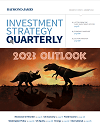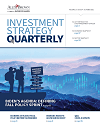There is no recent historical precedent for Joe Biden’s emergence as presumptive Democratic nominee after finishing a distant fourth or fifth place in Iowa and New Hampshire.
To read the full article from Washington Policy Analyst Ed Mills, see the Investment Strategy Quarterly publication linked below.
Key takeaways
- In our opinion, the medical, economic, and market outcome of COVID-19 will be a significant factor in the 2020 election. Should economic and health conditions continue to deteriorate, we expect a rise in expectations that Joe Biden captures the White House and a rise in the probability of an all-Democratic government.
- Biden is generally viewed as promoting policy goals from the political mainstream and could easily push more fiscal stimulus. This would be viewed as having a neutral to positive impact on the market compared to the prospect of a Sanders presidency (which weighed on markets earlier this year).
- Should COVID-19 avoid the worst-case scenarios and the economy/market have a significant recovery in the latter half of the year, the momentum is likely to swing back towards President Trump.
Biden emerges as presumptive nominee
A whirlwind Democratic primary appears to be nearing its conclusion with Vice President Biden emerging as the presumptive nominee (in our view) following a come-from-behind victory in South Carolina and a near-sweep in state victories through March. Biden currently leads Sanders with 1,215 delegates to Sanders’ 909, a sizeable lead (1,991 delegates are needed to clinch the nomination on the first ballot).
The winner of either the Iowa, New Hampshire, or South Carolina primary has gone on to become the Democratic nominee since 1952. As such, there is no recent historical comparison to Biden’s resurgence to the top of the pack after finishing a distant fourth or fifth place in Iowa and New Hampshire. The last Democratic candidate to emerge as the nominee without having won Iowa or New Hampshire was Bill Clinton in 1992, but Clinton technically tied New Hampshire’s popular vote winner (Tsongas) in the delegate count. It would be easy to say that Biden was expected to win the South Carolina primary, so the results were somewhat in line with expectations. However, his margin of victory (especially following distant finishes in the early states) is extremely noteworthy. In the lead up to South Carolina, there were a series of polls that showed Senator Sanders right on Biden’s heels. Unfortunately for Sanders, he emerged from South Carolina not much better than his 2016 result, which is ultimately where his momentum stalled out again in the 2020 race.
The coalescence behind Joe Biden as the clear alternative to Senator Bernie Sanders produced a much better than expected Super Tuesday result for the former Vice President. Former New York City Mayor Bloomberg picked up delegates, but massively underperformed expectations given he spent half a billion dollars on his campaign. Senator Elizabeth Warren came up short, including a loss in her home state of Massachusetts. However, she may have been an unsung hero for the Biden campaign given that she used the last two debates to halt the rise of Bloomberg and that she likely pulled liberal voters from Sanders. From there, Democratic voters overwhelmingly pivoted toward Biden as he stacked up a series of impressive wins and expanded his delegate lead over Senator Sanders. Biden also quickly racked up endorsements from his rivals, and his coalition is now being compared to that of President Obama’s in 2008. Biden’s victory in Michigan was of particular note, given that it was previously won by Sanders in 2016 and ultimately helped to reinvigorate/prolong Sanders’ challenge to Secretary Clinton.
The overall vote totals to date have supported the narrative that Senator Sanders is a high floor, but low ceiling candidate. Sanders won the delegate-rich state of California, his home state of Vermont, as well as Utah and Colorado. However, he fell short of the earlier delegate projections where he easily could have built an all but insurmountable lead in the delegate count. Senator Sanders consistently underperformed his 2016 vote totals, especially in Missouri and Michigan.
Previewing the general election and beyond
In our opinion, the medical, economic, and market outcome of COVID-19 will be a significant factor in the 2020 election. Should economic and health conditions continue to deteriorate, we expect a rise in expectations that Joe Biden captures the White House and a rise in the probability of an all-Democratic government. While he would swing the agenda away from the current Trump agenda (which has been received positively by the market over the past four years), Biden is generally viewed as promoting policy goals from the political mainstream and could easily push more fiscal stimulus. This would be viewed as having a neutral to positive impact on the market compared to the prospect of a Sanders presidency (which weighed on markets earlier this year). Should COVID-19 avoid the worst-case scenarios and the economy/market have a significant recovery in the latter half of the year, the momentum is likely to swing back toward President Trump. The big question will continue to be the effect of the current uncertainty on suburban voters. Incumbents are traditionally viewed as the safer choice, but Biden’s familiarity may upend this calculation as we expect a “return to normalcy” to be the primary message of the Biden general election campaign.
In terms of a second term for President Trump, the initial reaction would be that this is a positive for the market should we see post- COVID-19 recovery in the second half of this year. A wave of momentum could produce down-ballot impacts that bring back an all-Republican government. Sentiment would be boosted on the continuation of the Trump deregulatory agenda and stimulus via additional corporate/individual tax cuts. However, an open question would remain as to whether the lack of any additional electoral checks would produce an unbound and bombastic President Trump on policy issues. A mitigating factor for the market here would be that second-term presidents are motivated by their legacy, and, as Trump is especially cognizant of market/economic metrics, his policy objectives should continue to support a positive environment for macro fundamentals.
Read the full April 2020
Investment Strategy Quarterly
Read the full April 2020
Investment Strategy Quarterly
All expressions of opinion reflect the judgment of Raymond James and are subject to change.
Markets & Investing Members of the Raymond James Investment Strategy Committee share their views on...
Markets & Investing Review the latest Weekly Headings by CIO Larry Adam. Key Takeaways ...
Technology & Innovation Learn about a few simple things you can do to protect your personal information...

